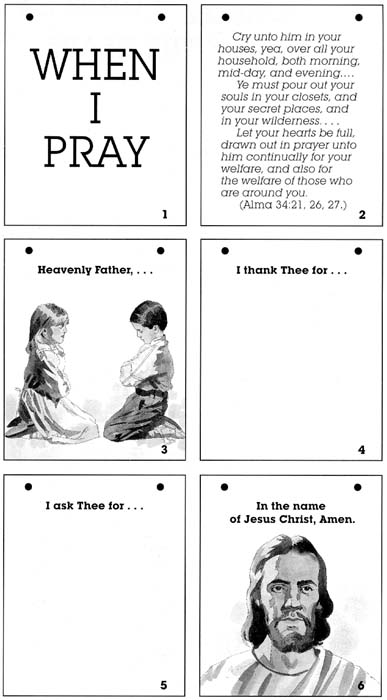“Sharing Time: Alma and Amulek Teach the Zoramites to Pray,” Friend, Feb. 1992, 12
Sharing Time:
Alma and Amulek Teach the Zoramites to Pray
But behold, I say unto that ye must pray always (2 Ne. 32:9).
A long time ago there lived a man named Alma. He was the chief judge (ruler) over his people, the Nephites. He was also the high priest over the Church. Alma was worried because the Church members cared more about their fine clothes, gold, and silver, than they did about Jesus Christ and Heavenly Father. And they did not take care of those who were hungry, poor, or sick.
Alma wanted to preach to his people in hopes that they would repent, so he selected another man to take his place as chief judge. Then he traveled to towns and cities throughout the land and preached the gospel. In one city, the Lord called a righteous man, Amulek, to accompany Alma.
One day Alma and Amulek went to the Zoramites. Among other things, the Zoramites had forgotten how to pray reverently. They had built synagogues, or churches, and in the middle of each was a tall stand, the top of which was high above the congregation. The stand was called a Rameumptom, or holy stand. One day each week, the people took turns climbing to the top of the Rameumptom. As each person reached the top, he would raise his hands toward heaven and in a loud voice repeat a boastful prayer. Each person said exactly the same prayer, then climbed down, went home, and never prayed or thought about God during the rest of the week.
Alma and Amulek taught the Zoramites who would listen to them that they could pray anytime, anywhere, that they could pray silently in their hearts, or out loud, and that they should not wait until they went to church on Sunday to pray. Amulek told them that they should pray continually—in their fields, in their homes, alone in their closets. Amulek taught them that they could pray to Heavenly Father about everything and that they should not just repeat the same words over and over again. He said that they should thank Heavenly Father for all the good things He had given them, that they should ask for the help and strength they needed, and that they should pray for others. He knew that if they did this, they would feel more reverent toward Heavenly Father. (See Alma 4, Alma 8, Alma 31, Alma 34.)
Like the Zoramites who listened to Alma and Amulek, we need to learn how to pray reverently. We begin by addressing our Heavenly Father; we thank Him for the blessings He has given us. We may ask Him for help and guidance, for protection, and for other things that we need. We end our prayers in the name of Jesus Christ, then say “Amen.”
Instructions
Cut the cards from this page and mount them on lightweight cardboard. Color the pictures on cards three and six. On card four, draw pictures of things you are grateful for. On card five, draw things you would like Heavenly Father to bless you with. To make a flip-chart to remind you of the basic parts of a prayer, punch holes in the cards where indicated, then fasten the cards together in order with string, ribbon, or metal rings.

Illustrated by Paul Mann
1 When I Pray
2 Cry unto him in your houses, yea, over all your household, both morning, mid-day, and evening. …
Ye must pour out your souls in your closets, and your secret places, and in your wilderness. …
Let your hearts be full, drawn out in prayer unto him continually for your welfare, and also for the welfare of those who are around you.
3 Heavenly Father, …
4 I thank Thee for …
5 I ask Thee for …
6 In the name of Jesus Christ, Amen.
Sharing Time Ideas
-
Divide the older children into small groups. Give each group one of the following scripture references: Luke 11:1–4; Col. 3:17; Enos 1:4; Enos 1:9; Enos 1:15–16; Alma 34:17–26; 3 Ne. 13:9–13; 3 Ne. 18:19–21; 3 Ne. 19:20–21; Moro. 7:26. Have each group read its scripture, looking for the four steps of prayer, and report on which steps are mentioned in its scripture. Demonstrate with one scripture before the children begin.
-
Ask the younger children to draw pictures of things they are thankful for and blessings they might ask for. Have the children cut out these pictures and paste them onto a large flip chart that the whole Primary can enjoy.
-
Find stories in Church manuals or magazines about children and prayer. Set up storytelling stations, using several leaders to tell stories. Rotate the children in groups so they get to hear each story.
-
Have the children dramatize stories from the Primary manuals or church magazines about prayer.
-
Ask several children to be on a panel. Tape questions about prayer to the other children’s chairs. Let them ask the questions to the panel members. Let the other children help the panel answer questions. Questions might include: When can we pray? How do we close our prayers?
-
Invite several members of the ward to tell the children about specific times they have had their prayers answered.